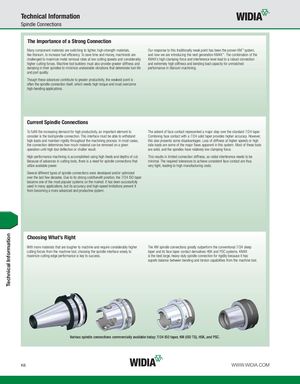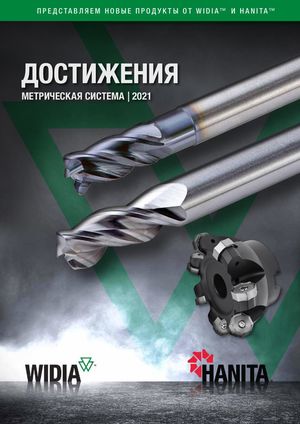Каталог Widia инструментальная оснастка - страница 1042
Навигация

Technical Information Spindle Connections The Importance of a Strong Connection Many component materials are switching to lighter, high-strength materials, Our response to this traditionally weak point has been the proven KM™ system, like titanium, to increase fuel efficiency. To save time and money, machinists are and now we are introducing the next generation KM4X™. The combination of the challenged to maximize metal removal rates at low cutting speeds and considerably KM4X’s high clamping force and interference level lead to a robust connection higher cutting forces. Machine tool builders must also provide greater stiffness and and extremely high stiffness and bending load capacity for unmatched damping in their spindles to minimize undesirable vibrations that deteriorate tool life performance in titanium machining. and part quality. Though these advances contribute to greater productivity, the weakest point is often the spindle connection itself, which needs high torque and must overcome high-bending applications. Current Spindle Connections To fulfill the increasing demand for high productivity, an important element to The advent of face contact represented a major step over the standard 7/24 taper. consider is the tool/spindle connection. This interface must be able to withstand Combining face contact with a 7/24 solid taper provides higher accuracy. However, high loads and maintain rigidity throughout the machining process. In most cases, this also presents some disadvantages. Loss of stiffness at higher speeds or high the connection determines how much material can be removed on a given side loads are some of the major flaws apparent in this system. Most of these tools operation until high tool deflection or chatter result. are solid, and the spindles have relatively low clamping force. High-performance machining is accomplished using high feeds and depths of cut. This results in limited connection stiffness, as radial interference needs to be Because of advances in cutting tools, there is a need for spindle connections that minimal. The required tolerances to achieve consistent face contact are thus utilize available power. very tight, leading to high manufacturing costs. Several different types of spindle connections were developed and/or optimized over the last few decades. Due to its strong cost/benefit position, the 7/24 ISO taper became one of the most popular systems on the market. It has been successfully used in many applications, but its accuracy and high-speed limitations prevent it from becoming a more advanced and productive system. Choosing What’s Right With more materials that are tougher to machine and require considerably higher The KM spindle connections greatly outperform the conventional 7/24 steep cutting forces from the machine tool, choosing the spindle interface wisely to taper and its face taper contact derivatives HSK and PSC systems. KM4X maximize cutting edge performance is key to success. is the best large, heavy-duty spindle connection for rigidity because it has superb balance between bending and torsion capabilities from the machine tool. Various spindle connections commercially available today: 7/24 ISO taper, KM (ISO TS), HSK, and PSC. K6 WWW.WIDIA.COM Technical Information
 Каталог Widia достижения 2021
Каталог Widia достижения 2021 Брошюра Widia решения для аэрокосмической промышленности
Брошюра Widia решения для аэрокосмической промышленности Брошюра Widia техническое руководство
Брошюра Widia техническое руководство Каталог Widia токарный инструмент 2020
Каталог Widia токарный инструмент 2020 Каталог Widia цельные концевые фрезы
Каталог Widia цельные концевые фрезы Каталог Widia техническое руководство по разверткам
Каталог Widia техническое руководство по разверткам